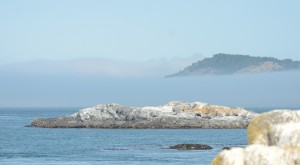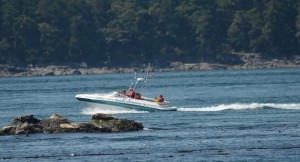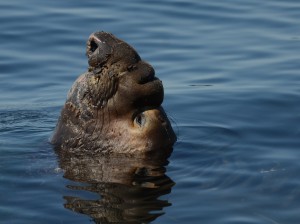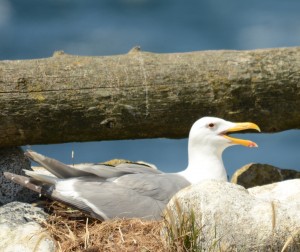The morning was relatively calm with west winds of 5 to 10 knots. As the day progressed wind speed picked up gradually. When the fog rolled in, early afternoon, the wind rose more and by 18:00, it was blowing the more usual, 25 – 30 knots. By sunset it had calmed right down to 10 -1 5 again. The sky was clear all day and the blue was even visible, looking straight up through the fog. The barometer dropped very slowly all-day and ended up at ~ 1014HPA. in the early evening. The forecast calls for continuing west winds increasing to 15-20 knots (strong wind warning) Sunday afternoon, with a mix of sun and cloud.
It was another busy whale-watching day at Race Rocks and 18 whale watching visits to the Ecological Reserve were noted. There were many more vessels that passed just outside the Reserve following pods of Southern Resident pods of Killer Whales. The usual Saturday dive charter operator also worked in the Ecological Reserve. Three sports fishing vessels came through as well and they mostly respected the speed restriction (7 knots) in the Ecological Reserve boundary.
Race Rocks was again at the centre of whale activity today. A large Humpback was feeding to the east early and then headed west through Race Passage and then off to the south. Several groups of Southern Resident Killer Whales passed through the Ecological Reserve, through Race Passage and over Rosedale Reef, with the afternoon/evening flooding tide. One group of three to four individuals came right through middle passage passing within meters of the end of the Jetty. According to the whale-watching fleet there were animals from both J and K pods going through Race Rocks at the same time. Biggs’ Killer Whales also passed by Race Rocks through Race Passage also heading east with the flooding tide.
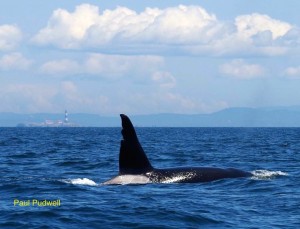
Chainsaw is the nickname for this big, male Killer Whale. Chainsaw is what we used to call a transient or T -killer whale. The Ts are now known as Biggs’ Killer Whales named after the late Mike Biggs who did ground-breaking, pioneering work on Killer Whale identification and social systems on the west coast. Photo thanks to Paul Pudwell.
The same three Northern Elephant Seals continue their moults on Great Race. There are no elephant seals left on Middle Rocks. The little, two-year-old, Stellers Sealion was joined by the one and only Californian, on South Islands and it was just as well they were hauled out with the Biggs Killer Whales around. The usual spots were filled with Harbour Seals at low tide.
Lots of Glaucous-winged Gulls were seen mouth open and panting, to cool their eggs today during the intense sunshine. The Black Oyster catchers continue to incubate as well and Pigeon Guillemots continue to mate. The main nesting sites for the Guillemots seem to be in the rock piles just west of the jetty, west of camera five and in the surge channel southwest of the science house. There is also scattered guillemot activity around the perimeter of the island especially in boulder and crevice areas. The ten Canada Goose goslings left are at different stages of development but quite a few of them are getting flight feathers now and the black and white colouration on the head and tail (like the adults) is starting to fill in.
An interesting sighting today was an Anna’s Hummingbird, spotted by Alex near the Science House. Missing in action was the Sea otter, which was nowhere to be seen today. There was quite a bit of Bald Eagle activity early on and that might have an effect but I was also thinking of the parade of 25 whale watching boats that all made up-close and personal connections with the sea otter a few days ago and wondering if it was just too much.
The sunshine continues to provide almost all of the electrical power requirements for the island. There were no visitors today and chores were routine.

